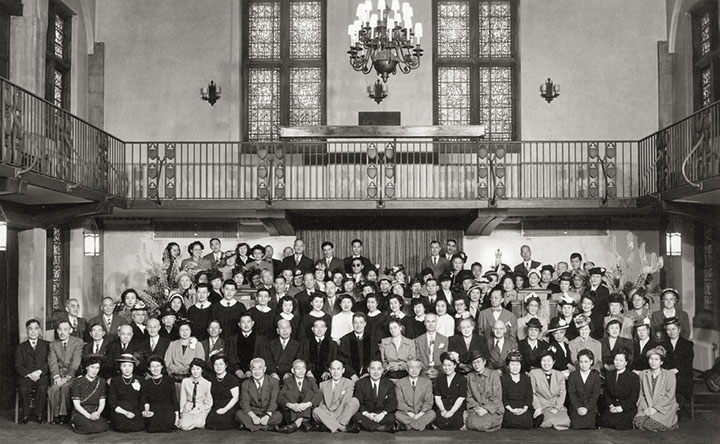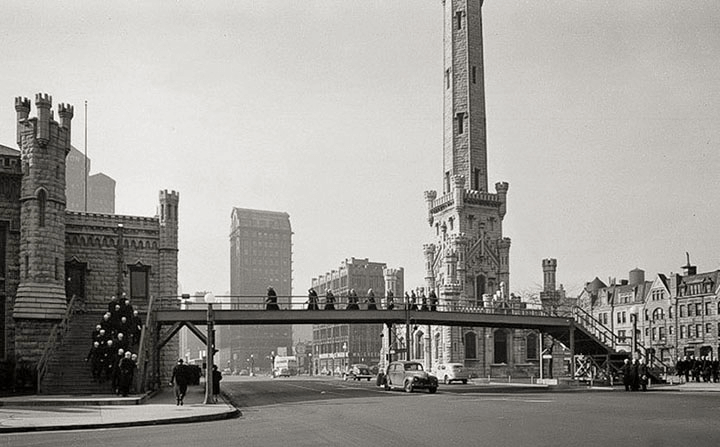“Other Christians helped us rebuild after the Chicago Fire. It’s our turn now for our brethren round the world.”
—Harrison Ray Anderson, 1947
Although the Great Depression had largely forced Fourth Church to look inward during the 1930s, the outbreak of World War II in 1939 soon asked the church to think more globally. Fourth Church organized a Red Cross effort the following year to create thousands of surgical dressings and hospital gowns to send to the rapidly unfolding war in Europe. After Japan’s surprise attack on Pearl Harbor on December 7, 1941, and the United States’ declaration of war, more than 400 church members would go on to serve in the war effort.

During the war years Fourth Church welcomed into its midst military personnel stationed nearby, including at Navy Pier (seen at lower right here). This photograph depicts the USS Sable and the USS Wolverine, former Great Lakes passenger steamships that were converted during the war into unarmed and unarmored aircraft carriers that were used for pilot training in Lake Michigan near the pier. More than 15,000 Navy pilots learned to take off and land on these two coal-fired vessels, including a 20-year-old George H. W. Bush.
In the midst of the war, Fourth Church also found itself called to serve in a different way. In May 1942, Fourth Church Pastor Harrison Ray Anderson received a request from the President of Chicago Theological Seminary asking if Fourth Church could provide space for a Japanese–American congregation to worship. This congregation had been harassed by police at the storefront where they had previously worshiped, and they were looking for a safe place to gather.
Although the request was unexpected, Fourth Church already held a long history of partnerships with churches across the city. As early as 1872, Fourth Church and its members were deeply involved in the genesis of several churches—contributing to those churches’ building costs, hiring staff, and providing ongoing financial support. Among the churches were the Howe Street Mission (1872), which eventually became Christ Church Presbyterian (1900); the Persian/Assyrian Mission Church (1903); and the Hubbard Bohemian Mission (1910), all of which were eventually recognized by the Presbytery of Chicago as independent congregations.
Welcoming the Japanese–American congregation certainly fit Fourth Church’s legacy as a supporter of Christian ministry, but there was also no doubting where the wider public sentiment was. Just a few months prior, Franklin Roosevelt had issued Executive Order 9066, which led to the incarceration of more than 100,000 people with Japanese ancestry—most of whom were U.S. citizens—in concentration camps. Nonetheless, Anderson insisted that welcoming this congregation was the Christian thing to do, and he managed to convince the church’s Session (who held the final say) to begin welcoming the congregation in the fall of 1942.


Fourth Church Pastor Harrison Ray Anderson poses with the Japanese – American congregation in Westminster Chapel (now named Anderson Hall in his honor). Over the years, numerous changes have been made to the area shown here, including removal of the balcony under the windows and the addition of three doorways that now lead to the Commons.
Accounts differ as to the level of backlash that Anderson faced from this decision. One woman who attended the Japanese–American services as a visitor remarked that few people even knew that the congregation was worshiping within the confines of Fourth Church. Other accounts write of Anderson standing at the door while they worshiped, presumably to protect this congregation from neighbors (or, more likely, church members) who knew about the decision to house them. Regardless, it’s difficult to imagine that Anderson would not have faced some level of pushback, but he proudly maintained that this was the church’s duty.
The congregation continued to worship at Fourth Church during and after the war, later joining the Chicago Presbytery as the Church of Christ (Japanese) in 1947 and worshiping in Westminster Chapel until 1953. Masaya Hibino, one of the pastors from the Church of Christ (Japanese), would later reflect, “In those days it was not popular for the American to be friends of Japanese. Even some professing Christians . . . withdrew themselves and disassociated themselves. In such a time as that, Dr. Anderson was a true Christian friend.”

During World War II so many military personnel-in-training were crossing Michigan Avenue to get to the Chicago Avenue Armory that this special overhead walkway was constructed a block south of Fourth Church, at Pearson and Michigan (note the white-capped midshipmen descending the stairs at left). The enormous Armory one block east was used for artillery brigades and cavalry training (“200 horse stalls”), and the building survived until the early 1990s, when it was demolished and replaced by the Museum of Contemporary Art.
Amazingly, the seeds of this faithful act would also continue to bear fruit decades later. In gratitude to Fourth Church, the Church of Christ (Japanese) gave Anderson some money “to be used for some good cause” on his visit to the newly formed World Council of Churches in 1948. Anderson purchased two Celtic crosses from Iona, Scotland, and presented these crosses to the two Moderators of the divided “Northern” (UPCUSA) and “Southern” (PCUS) Presbyterian denominations, a division started by Anderson’s own great-grandfather at a General Assembly back in 1861!
Anderson longed to be a part of bringing these two denominations back together, but despite several unsuccessful votes for reunion over the years, the crosses he purchased continued to be passed down separately—along with a shared hope that those two crosses might one day be reunited. Although he unfortunately did not live to see it in his lifetime, “Northern” and “Southern” Presbyterians did indeed reunite in 1983 to become the Presbyterian Church (USA)—(PCUSA)—an occasion marked by a joining of the two crosses Anderson had purchased back in 1948.
Anderson’s unyielding commitment to do what he felt was right certainly led him to do remarkable and courageous things. However, as we’ll explore next month, his spirit of resistance could also be a double-edged sword, as both he and Fourth Church were disappointingly slow to embrace two important movements building in the 1950s: the civil rights movement and an increased involvement of women in church leadership across the denomination.
• • •
< Back to Part 5 • On to Part 7 >